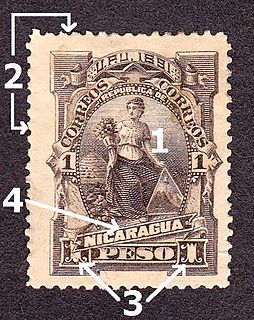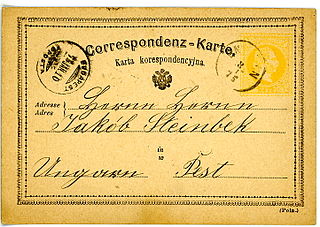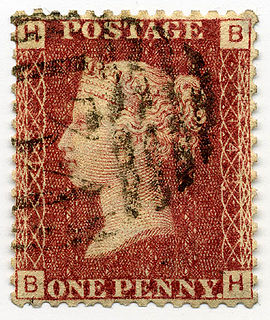
Stamp collecting is the collecting of postage stamps and related objects. It is related to philately, which is the study of stamps. It has been one of the world's most popular hobbies since the late nineteenth century with the rapid growth of the postal service, as a never-ending stream of new stamps was produced by countries that sought to advertise their distinctiveness through their stamps.

A piece of postal stationery is a stationery item, such as a stamped envelope, letter sheet, postal card, lettercard, aerogram or wrapper, with an imprinted stamp or inscription indicating that a specific rate of postage or related service has been prepaid. It does not, however, include any postcard without a pre-printed stamp.

The Penny Red was a British postage stamp, issued in 1841. It succeeded the Penny Black and continued as the main type of postage stamp in the United Kingdom of Great Britain and Ireland until 1879, with only minor changes to the design during that time. The colour was changed from black to red because of difficulty in seeing a cancellation mark on the Penny Black; a black cancel was readily visible on a Penny Red.
This is a list of philatelic topics.
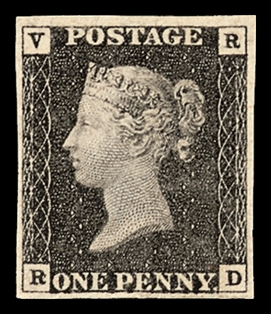
The VR official was one of three postage stamps introduced by the United Kingdom of Great Britain and Ireland in May 1840 for the pre-payment of postage. While the Penny Black and the Two Pence Blue were for use by the general public, as were the Mulready envelopes and letter sheets, the VR official was for use on official mail. In appearance the VR Official was the same as the issued Penny Black except that the Maltese crosses in the top corners were removed and replaced by the letters V and R, hence its common name.
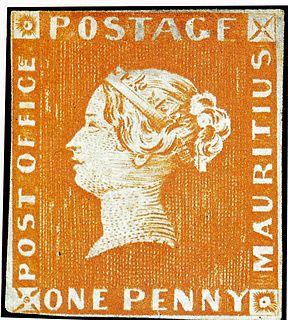
The Mauritius "Post Office" stamps were issued by the British Colony Mauritius in September 1847, in two denominations: an orange-red one penny (1d) and a deep blue two pence (2d). Their name comes from the wording on the stamps reading "Post Office", which was soon changed in the next issue to "Post Paid". They are among the rarest postage stamps in the world.

John Harry Robson Lowe, Robbie to his friends, was an English professional philatelist, stamp dealer and stamp auctioneer.

Mauritius, a small island in the southwest Indian Ocean, is of towering importance in the world of philately for a number of reasons. Its first two postage stamps issued in 1847, called the "Post Office" stamps, are of legendary rarity and value. They were the first stamps issued in any part of the British Empire outside of Great Britain. The unique cover bearing both “Post Office” stamps has been called "la pièce de résistance de toute la philatélie" or "the greatest item in all philately". The cover was sold at auction, in Zurich, on 3 November 1993, for 5.75 million Swiss francs, the equivalent of about $4 million – the highest price ever paid for a single philatelic item up to that time. In addition, Mauritius is well known for the subsequent locally produced issues known as "primitives," also prized by collectors.
In philately the Admirals are a series of definitive stamps issued by three countries of the British Commonwealth which show King George V, King of the Great Britain and the British Dominions. The stamps are referred to as the Admirals because King George is depicted in his Admiral of the Fleet uniform. The stamps were issued by Canada (1911–28), New Zealand (1926), and Rhodesia (1913–24).
Bertram McGowan (1874–1950) was a Scottish solicitor and philatelist who specialised in Chile and the Postage stamps and postal history of Great Britain, especially Great Britain used abroad.
The Stamp Specialist is the title of a series of books on philatelic research written and edited for the advanced collector of postage stamps.

A specimen stamp is a postage stamp or postal stationery indicium sent to postmasters and postal administrations so that they are able to identify valid stamps and to avoid forgeries. The usual method of invalidating the stamps is either overprinting in ink or perforating the word Specimen across the stamp and where English is not the common language, the words Muestra (Spanish), Monster (Dutch), Muster (German) or Образец have been used instead.

In philately, an imprinted stamp is a stamp printed onto a piece of postal stationery such as a stamped envelope, postal card, letter sheet, letter card, aerogram or wrapper. The printing may be flat upon the surface of the paper, or embossed with a raised relief. An imprinted stamp is also known as unadhesive stamp or indicium.

Centro de hoja or Center of the sheet is a kind of Cuban postage stamps where there are intersecting gutters between four panes of stamps. The horizontal and vertical blank gutters divide the sheet into quadrants of 25 stamps each. The center four or sixteen stamps on a sheet of 100 stamps are collected similar to how plate blocks of four stamps are collected in the United States. The first centro de hoja were the imperforate Cuban patriots issues of 1926. These had the unique distinctions of being from sheets of 400 rather than 100 and the "gutters" consisted of nothing more than two intersecting lines drawn through the center of the sheet. The last was produced with the three bicentennial of coffee issues of 1952. Some people classify the Christmas issues of 1960 as centros de hoja, but since they have no gutters others call them special format stamps.
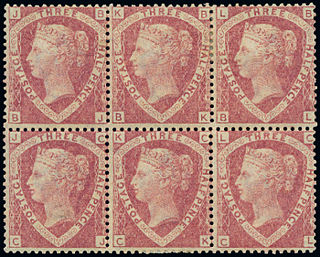
The Three Halfpence Red, first issued on 1 October 1870, was the first Three Halfpenny postage stamp issued in the United Kingdom.

The Ferrer block is a corner block of 15 of the 80 centésimos green 1856 'Diligencia' (Suns) postage stamps, and is regarded by many philatelists as the most important item of Uruguayan philately. Fred Melville, speaking philatelically, called it "one of the seven wonders of the world". It is the largest known multiple of this issue of which only a few blocks are known to exist. Most of the plating information about this issue has been derived from this one block.

